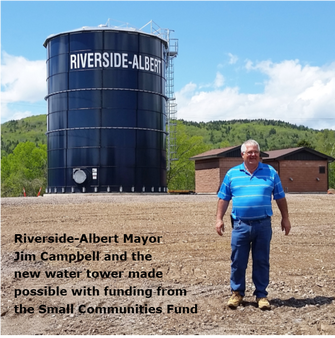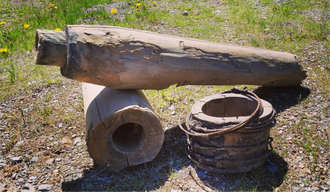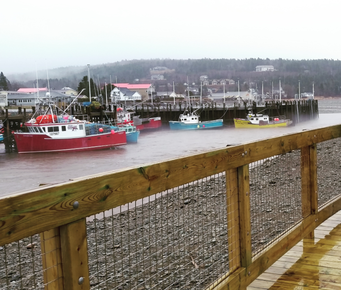
“It all started in 1920,” says Heather Cail, Public Works Superintendent for the Village of Riverside-Albert. “A shopkeeper from Albert, Mr. Anderson, got the community together to develop a better water system. The sand and gravel in the ground there doesn’t hold water so they couldn’t dig wells for homes and fire protection.
 Original wooden pipes installed in 1920. The two longer pipes fit into one another, with the small 'bell' sealing them together; 3-4 km of this pipe was hand laid to gravity feed water into Albert.
Original wooden pipes installed in 1920. The two longer pipes fit into one another, with the small 'bell' sealing them together; 3-4 km of this pipe was hand laid to gravity feed water into Albert. “The townfolk pooled their resources to put in a water system on the top of a hill in the Arabian Vault Brook Watershed. This spot had a high enough elevation to gravity feed water down to the village and more than met the professor’s criteria.”
The location falls within the 9 hectares that now belong to the Village of Riverside-Albert, a sub-section of the 132-hectare section of the Acadian Forest watershed now protected by Nature Conservancy Canada.
“The townfolk set to work damming the brook and hand laying 3-4 km of wooden pipe,” Cail says. The original wooden pipes were replaced in the 1980s, “but the dam and collection system they built has lasted until today.”
She shows me pieces of the wooden pipes. I struggle to imagine the amount of work that must have gone into the original project. Villagers and visitors to Riverside-Albert have some idea of how much work has gone into the new water system. Last summer and fall, the transmission pipes were dug up and replaced after it was determined the pipes were leaking water treated with chlorine. Replacing the leaky pipes cut the village’s water consumption by a whopping 40%.
This spring, a blue water tower sits proudly at the edge of the village, made possible by the Small Communities Fund, part of the Building Canada Fund.
“In 1996-97, the village installed a UV disinfection system. Then new standards came into effect requiring the village to remove turbidity and add chlorine for continuous disinfection,” Cail tells me.
Turbidity is a measure of a liquid’s cloudiness. During rainstorms, sediment and plant particles wash into waterways and cloud the water. This cloudiness has been the biggest challenge to clean water for the village.
“We received a grant in 2008 to put in a system to treat the water, but this system couldn’t keep up with Heavy Rain Events,” Cail says. I can hear her capitalize the words as she says them. For a full decade, these Heavy Rain Events have put the village of Riverside-Albert on a boil order.
“During periods of high turbidity the plant filters clog up. The system doesn’t have enough water in reserve to do a backwash to unclog them. It takes 24 hours after a rainstorm to clear the water, and another two days of clean water tests before a boil order can be lifted,” Riverside-Albert Mayor Jim Campbell tells me.
“During a boil order, it is vital that no one, but especially infants, elderly, or anyone with a vulnerable immune system, drinks the water before boiling it,” says Mayor Campbell. “This presents a huge challenge for families, our school, businesses, and seniors’ residences like Forest Dale Home.”
Vicki Caissie, Administrator for Forest Dale Home, says “the boil orders have been inconvenient and certainly a financial burden. We’ve had to bring in bottled water and buy ice. Special events are especially challenging with guests from outside the village who aren’t familiar with the boil order.”
Principal Barry Snider of Riverside Consolidated School tells me they haven’t been able to use their water fountain at all since September. “The school district brings in bottled water for the water cooler and we use paper cups when we need them.” Students also bring reusable water bottles to school.
“It’s little things like adding water when you heat up a child’s lunch or washing fruit that make it complicated,” says Principal Snider.
A Boil Water Advisory posted on the window of Riverside-Albert’s Village Office advises all water destined for consumption or washing fruits and vegetables be boiled for a full minute. It further suggests caregivers sponge bathe infants and toddlers to prevent them swallowing any water.
“When the new system is up and running, the boil orders should become a thing of the past,” says Mayor Campbell. “The system has an automatic shut-off when it senses turbidity and will switch to the reserve water stored in the tower.”
“The village’s reserve water has increased to three days’ worth,” Heather Cail tells me. “Before we had 1.5 hours of water in reserve.”
“The important thing,” says Mayor Campbell, “is that we can now have growth in our community.”
 Alma Harbour from the Boardwalk
Alma Harbour from the Boardwalk The Village of Hillsborough received partial funding through the Government of Canada’s Small Communities Fund to upgrade the village’s wastewater systems. These upgrades, including three new lift systems, will help lessen the flow of storm water into the present system and reduce overflow incidents. Albert County residents may have noticed the work crews and excavators installing the lift systems along Main Street/Route 114 in Hillsborough.
Shoreline protection
Work is now complete on the Shoreline Protection projects in Alma, made possible by the Federal Infrastructure Project Fund. An increase in storm frequency and intensity attributed to climate change has placed the shoreline along Route 114 from Alma into Fundy National Park in jeopardy. An installation of armour rock, rock used to protect (armour) coastlines, is now in place. Residents of Albert County may have seen trucks hauling the large armour rocks to the project over the past year.
Local tree species and grasses were planted to stabilize the area. A new boardwalk curves along the shore, providing beach access and protection for sensitive vegetation. Visitors have gained a wonderful vantage point of Alma harbour, the dramatic tides, and its colourful fishing boats.
 RSS Feed
RSS Feed